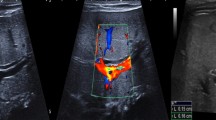Abstract
We performed serial ultrasonic examinations to differentiate biliary atresia from neonatal hepatitis. The subjects studied were 144 children (100 normal neonates and infants, 31 patients with neonatal hepatitis and 13 patients with biliary atresia). They were examined by ultrasound before, during and after feeding. In 97 out of 100 normal children and all patients with neonatal hepatitis, the gallbladder was identified, and the change in size following oral feeding was observed. In four children with severe neonatal hepatitis which could not be differentiated from biliary atresia by clinical and laboratory data, we readily identified the gallbladder and observed the change in the size following oral feeding. In 8 of 13 patients with biliary atresia, we identified a small gallbladder whose size was not affected by oral feeding. In the other patients the gallbladder was not identified before, during or after oral feeding. On the basis of these results, we consider that serial ultrasonic examination with oral feeding aids in a differential diagnosis of biliary atresia and neonatal hepatits.
Similar content being viewed by others
References
Abramson SJ, Treves S, Teele RL (1982) The infant with possible biliary atresia evaluation by ultrasound and nuclear medicine. Pediatr Radiol 12:1–5
Altman RP, Abramson S (1985) Potential errors in the diagnosis and surgical management of neonatal jaundice. J Pediatr Surg 20: 529–534
Brun P, Gauthier, D, Boucher D, Brunelle F (1985) Ultrasound findings in biliary atresia in children. Ann Radiol (Paris) 28:259–263
Carroll BA, Oppenheimer DA, Muller HH (1982) High-frequency real-time ultrasound of the neonatal biliary system. Radiology 145:437–440
Chiba T, Kasai M (1975) Differentiation of biliary atresia from neonatal hepatitis by routine clinical examinations. Tohoku J Exp Med 115:327–335
Finberg HJ, Birnholz JC (1979) Ultrasound evaluation of the gallbladder wall. Radiology 133:693–698
Gates GF, Sinatra FR, Thomas DW (1980) Cholestatic syndromes in infancy and childhood. AJR 134:1141–1148
Greene HL, Helinek GL, O'Neil J (1979) A diagnostic approach to prolonged obstructive jaundice by 24-hour collection of duodenal fluid. J Pediatr 95:412–414
Hays DM, Wooley MM, Synder WH, Reed GB, Gwinn JL, Landing BH (1967) Diagnosis of biliary atresia relative accuracy of percutaneous liver biopsy and operative cholangiography. J Pediatr 71:598–607
Kasai M, Suzuki H, Ohashi E, Ohi R, Chiba T, Okamoto T (1978) Technique and results of operative management of biliary atresia. World J Surg, 2:571–580
Kawai S, Kobayshi A, Ohbe Y (1978) Diagnosis of congenital biliary atresia with reference to the differential diagnosis, from neonatal hepatitis. Jpn J Pediatr Surg 10:619–628
Kirks DR, Coleman RE, Filston HC, Rosenberg ER, Merten DF (1984) An imaging approach to persistent neonatal jaundice. ARJ 142:461–465
McGahan JP, Phillips HE, Cox KL (1982) Sonography of the normal pediatric gallbladder and biliary tract. Radiology 144:873–875
Miyano T, Suruga K, Kimura K (1981) Suruga II procedure for preventing the postoperative ascending cholangitis in biliary atresia. Jpn J Pediatr Surg 13:745–748
Ohi R, Hanamatsu M, Mochizuki I, Chiba T, Kasai M (1985) Progress in the treatment of biliary atresia. World J Surg 9:285–293
Peters H, Eißner D, Weitzel D, Dinkel E, Hahn K, Baumann W, Hofmann-v. Kap-herr S (1988) The diagnostic significance of cholescintigraphy and ultrasound examination in cholestatic syndromes in infancy. Pediatr Surg Int 3:37–42
Tazawa U, Konno T (1981) Serum lipoprotein-X in differential diagnosis of neonatal hepatitis and congenital biliary atresia. Jpn J Pediatr Surg 13:775–779
Author information
Authors and Affiliations
Rights and permissions
About this article
Cite this article
Ikeda, S., Sera, Y. & Akagi, M. Serial ultrasonic examination to differentiate biliary atresia from neonatal hepatitis — special reference to changes in size of the gallbladder. Eur J Pediatr 148, 396–400 (1989). https://doi.org/10.1007/BF00595895
Received:
Accepted:
Issue Date:
DOI: https://doi.org/10.1007/BF00595895




